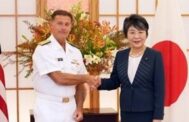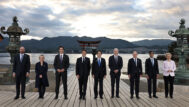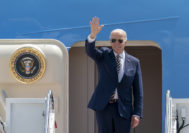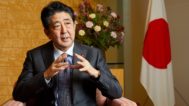Authors
Brad Glosserman

Brad Glosserman is deputy director of and visiting professor at the Tama University Center for Rule Making Strategies and senior advisor for Pacific Forum, where, among other things, he co-edits Comparative Connections. For 15 years, he was the executive director of Pacific Forum. He is the author of Peak Japan: The End of Grand Ambitions (Georgetown University Press, 2019), and co-author, with Scott Snyder, of The Japan-ROK Identity Clash (Columbia University Press, 2015). He has authored dozens of monographs on topics related to US foreign policy and Asian security. His opinion articles and commentary have appeared in media around the world. Prior to joining Pacific Forum, he was, for 10 years, a member of The Japan Times editorial board, and continues to serve as a contributing editor for the newspaper. Glosserman has a J.D. from George Washington University, an M.A. from Johns Hopkins University’s School of Advanced International Studies (SAIS) and a B.A. from Reed College.
Articles by Brad Glosserman

Regional Overview
September — December 2023The “Year of Elections” is Upon Us!
The major multilateral gatherings of the past year’s final trimester—the East Asia Summit (EAS) and associated ASEAN-arranged summitry in Indonesia in early September, the India-hosted G20 Summit a week later (Sept. 9-10 in Delhi), the ASEAN Defense Ministerial Meeting-Plus (ADMM-Plus) in Indonesia, and the concurrent Asia Pacific Economic Cooperation (APEC) Leaders Meeting in San Francisco on Nov. 16-17—were largely overshadowed by events (very) near and far away. The EAS and G20 Summits were most notable for who wasn’t there. Russian President Vladimir Putin skipped both meetings, sparing the hosts of the challenge (or embarrassment) of honoring (or ignoring) the international arrest warrant issued for him stemming from the Kremlin’s invasion and war against Ukraine. Those hoping for a fence-mending summit between Chinese President Xi Jinping and US President Joe Biden at the EAS or G20 were doubly disappointed; Xi skipped both meetings, while Biden only attended the G20, leaving the EAS to Vice President Kamala Harris.

US - Japan
September — December 2023As Good as it Gets?
The US-Japan relationship may well be at its all-time best. Animated by a concordance of vision and interests, the two governments are closely coordinating across a wide range of issues in a variety of venues—bilateral and multilateral, political, economic, and military. Concern about the potential destabilizing effects of regional developments provides considerable motivation for the two to work together. The final reporting period of 2023 provided ample evidence of their convergence. If that past is prologue, the year ahead should be a good one. Unfortunately, however, the tide could be turning. A political funds scandal has ensnared Japan’s ruling Liberal Democratic Party (LDP), and the approval ratings of the government of Prime Minister Kishida Fumio are plummeting as a result. Even if the prime minister survives the scandal—and most indications are that he will—he will be tarred and distracted as the region and the world face new and mounting challenges.

Regional Overview
May — August 2023Regional Overview: Building Partnerships Amidst Major Power Competition
Major power competition was the primary topic du jure at virtually all of this trimester’s major multilateral gatherings, with Russia’s invasion of Ukraine continuing to serve as a litmus test—a test many participants struggled to avoid taking. It was clear which side of the fence the G7 leaders stood on; Putin’s invasion was soundly condemned and Sino-centric warning bells were again gently sounded. At the BRICS Summit and Shanghai Cooperation Organization (sans the US), those alarms were clearly muted, as they were at the ASEAN Regional Forum, at which foreign ministers from all three were present. Headlines from the IISS Shangri-la Dialogue focused on the meeting that did not occur, as China’s defense minister pointedly refused to meet with his US counterpart. At the ASEAN-ISIS’ Asia-Pacific Roundtable, participants lamented the impact of major power tensions on ASEAN unity, even though ASEAN’s main challenges are internal ones that predate the downturn in China-US relations. Meanwhile, Beijing and Washington both expended considerable effort at these and other events throughout the reporting period fortifying and expanding their partnerships, even as many neighbors struggled not to choose sides or to keep a foot in both camps.

Regional Overview
January — April 2023“Like-Minded Minilateralism” Coming of Age
As broad-based multilateral organizations seem to be increasingly unable (or unwilling) to tackle the major security challenges of the day—Russia-Ukraine, China-Taiwan, North Korea, and Myanmar, to list but a few—more focused “minilateral” efforts involving “like-minded” allies and partners are coming to the fore. Foremost among the dysfunctional are the United Nations Security Council (UNSC) and broader UN mechanisms, thanks to Russian and Chinese intransigence. Sadly, ASEAN-led mechanisms like the East Asia Summit and ASEAN Regional Forum, not to mention ASEAN itself, also fall into this category, as does the G20, whose foreign ministers failed to reach any meaningful conclusions at their early March 2023 meeting, their first with India at the helm. Enter the Quadrilateral Security Dialogue (or “Quad,” involving Australia, India, Japan, and the United States), AUKUS (Australia-United Kingdom-US technical cooperation agreement), various minilateral cooperative efforts (including US-Japan-Philippines and US-Japan-Korea), and a resurgent like-minded G7, now that its (failed) experiment of drawing Russia and China into its process has come to an inglorious end. But not all new efforts are succeeding. President Biden hosted his second “Summit of Democracies” which drew little fanfare or attention.

ROUNDTABLE
January 24, 2023Indo-Pacific Policy in the 2nd Half of Biden’s Term

Regional Overview
September — December 2022Indo-Pacific as the “Epicenter”
The Biden administration released its long-awaited National Security Strategy (NSS) this reporting period, along with unclassified versions of its National Defense Strategy and Missile Defense and Nuclear Posture Reviews. There were no big surprises. The NSS identified the Indo-Pacific as “the epicenter of 21st century geopolitics” and reaffirmed China as the “pacing challenge,” even while branding Russia as “an immediate threat to the free and open international system” as a result of its invasion of Ukraine. Underscoring the priority attached to the region, President Biden attended the East Asia Summit in Phnom Penh and the G20 Summit in Bali, with Vice President Kamala Harris representing the United States at the annual Asia Pacific Economic Cooperation (APEC) Leaders’ Meeting in Bangkok. Kim Jong Un was not invited to any of the Asia summits but found other ways to attract attention, including some 70 ballistic missile launches for the year while announcing plans to rapidly produce and potentially use tactical nuclear weapons. Chinese President Xi Jinping, when not busy defending Pyongyang’s bad behavior, was busy orchestrating the 20th National People’s Congress, where he was elected “president for life.”

Regional Overview
May — August 2022Washington “Pivots” to Asia
The Biden administration has rediscovered Asia. And, for better or worse, so has the US Congress. While the administration’s national security documents (or at least their unclassified sneak previews) have identified the Indo-Pacific as a priority theater vital to US national security and China as “our most consequential strategic competitor and the pacing challenge,” Europe continues to steal headlines and the lion’s share of the administration’s (and international media’s) attention, thanks to Vladimir Putin and his unwarranted (and so far unsuccessful) invasion of Ukraine.
While many eyes remain on Putin’s war (and NATO’s US-led solid support for Kyiv), this reporting period saw President Biden finally make his first trip to Asia to visit longstanding US allies and attend the second in-person Quadrilateral Security Dialogue (“Quad”) Summit. Prior to his trip, Biden hosted his first US-ASEAN Summit in Washington. Meanwhile Secretary of Defense Lloyd Austin and Secretary of State Antony Blinken were both in Southeast Asia, respectively for the Shangri-La Dialogue and for various ASEAN-driven ministerials. These administration trips were largely overshadowed, however, by US Speaker of the House Nancy Pelosi’s controversial trip to Taiwan, the first by a House Speaker in 25 years, which was sure to—and clearly did—draw Beijing’s ire.
The US administration also (finally) put some meat on the bones of its Indo-Pacific Economic Framework, even though (like Obama’s earlier pivot) the trade and economic dimension of the administration’s Indo-Pacific Strategy remains the least developed. The military dimension of the strategy was much more in evidence, highlighted by the Rim of the Pacific (RIMPAC) exercise and a number of other multilateral training events throughout the region. Multilateralism will continue to capture the headlines as we move into the year’s third trimester with the ASEAN-driven East Asia Summit and Asia-Pacific Economic Cooperation (APEC) Leaders’ Meeting sharing pride of place with the Indonesia-hosted G20 Summit.


Regional Overview
January — April 2022Ukraine Seizes the Headlines Amid Mounting Concerns About China
International attention during the first trimester of 2022 quite naturally focused on the Russian invasion of Ukraine, amid heavy (and often breathless) speculation regarding its political, security, and economic implications for Asia in general and China-Taiwan in particular. Largely overlooked (except by us) has been the release of the Biden administration’s Indo-Pacific Strategy and the classified versions of the National Defense Strategy (NDS), Nuclear Posture Review (NPR), and Missile Defense Review (MDR). Still missing in the Indo-Pacific Strategy are specifics regarding the Indo-Pacific Economic Framework (IPEF), first unveiled (sans details) by President Biden at last October’s East Asia Summit, which supposedly encompasses the trade and economic dimension of the administration’s Asia policy. Also still missing is the all-encompassing National Security Strategy (NSS), which traditionally precedes these documents. It was reportedly sent back to the drawing board following the Russian attack.
Events in the opening trimester of the year also raised both hopes and concerns regarding the viability of the Quad, the increasingly more formal collaboration among Australia, India, Japan, and the United States. The Australia-UK-US (AUKUS) enhanced security partnership also made progress, to the delight of its members.

Regional Overview
September — December 2021Multilateralism (Still) Matters, as New Indo-Pacific Strategy Emerges
While the Biden administration has yet to produce its own definitional strategy documents—the National Security Strategy, National Defense Strategy, Nuclear Policy Review, or Indo-Pacific Strategy Report—details are emerging that strongly suggest each will be generally consistent with the previous administration’s reports, but with an even heavier stress on alliances and multilateralism. Secretary of State Antony Blinken provided the most detailed description of the administration’s Indo-Pacific strategy during his swing through Southeast Asia in December, reaffirming the “cooperate, compete, confront” approach toward China that, with varying degrees of emphasis and intensity, has been consistent for at least the last three administrations. Meanwhile Secretary of Defense Lloyd Austin put some meat on the bones of his “integrated deterrence” concept, underscored by the first in-person (despite COVID) summit meeting of the four Quad heads of state from Australia, India, Japan, and the United States and the emergence of AUKUS, a technology-oriented defense arrangement involving Canberra, London, and Washington.
President Biden (virtually) attended the ASEAN-driven East Asia Summit and Asia Pacific Economic Cooperation (APEC) Leaders Meeting while focusing much of his attention on the broader-based Summit for Democracy. While the administration talked in general terms about its Asian economic strategy, the Comprehensive and Progressive Agreement on Trans-Pacific Partnership (CPTPP) and Regional Comprehensive Economic Partnership (RCEP) continued apace, sans Washington, with Beijing knocking on the former’s door and standing to be a prime beneficiary (along with Japan) of the latter. Overshadowing all of this is omicron, the latest and seemingly most contagious and pervasive COVID strain, reminding us all that the pandemic is far from over.